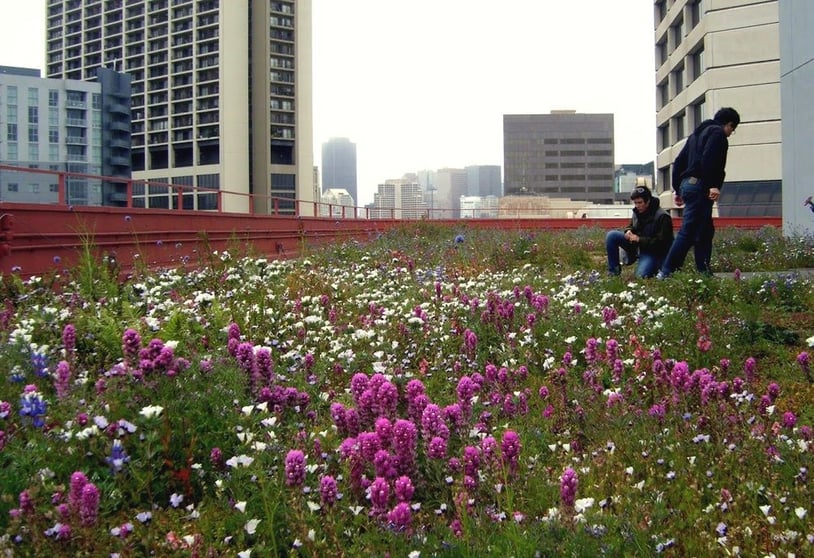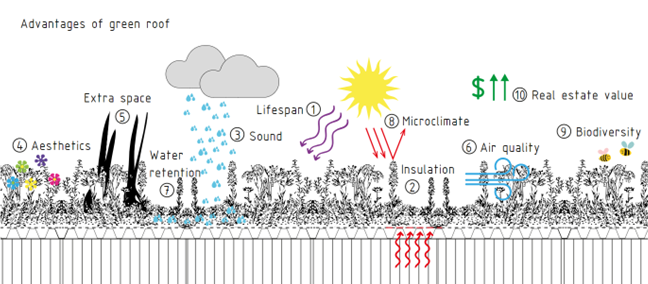Green infrastructure, such as green roofs and walls, can fulfil several urban and ecological functions, providing natural resource sinks to assist urban climate control, water management and form important green networks. Importantly, it also has positive social and psychological impacts (1).
Social and Psychological Benefits
Introducing green infrastructure to communities helps provide access to green spaces for exercise, recreation and regeneration, promotes social cohesion and helps create attractive places to live (1). Various urban design and architecture theorists and planners like Lynch (1960, 1981), (Jacob (1961) Alexander (1977) and (Gehl 1989) have acknowledged how peasant building frontages and streetscapes can help in enhancing social interaction. They stress that for public spaces to function and attract people, they need to be comfortable, usable in all seasons, welcoming, accessible to all, adaptable, legible and memorable enough to allow people to establish an association with space. Green infrastructure at the street level has the potential to assist in that. Green walls, for example, can contribute to this by providing a pleasantly cool environment in the summer. They can also assist in wayfinding in the urban environment and help with orientation, combat air pollution, offer space for gathering, increase the aesthetic value of a site and activate the street edge that might otherwise be unattractive and underused (2).
Stress Less, Feel Better
In terms of health and well-being benefits, a study has shown that symptoms like cough, fatigue, and dry or itchy skin are reduced by 37, 30, and 23% when in the vicinity of greenery. A virtual reality experiment has also indicated that vertical greenery has good potential to reduce stress perception in urban dwellers. Participants were asked to walk through two scenarios, first a noisy street with buildings covered with green walls. In the second setup, participants were led through a similar noisy street where green walls were replaced by only green paint. The participants’ stress levels did not increase when moving through the space with green walls, but they increased when walking through the same area without greenery, only using green paint. This indicates that the visible vegetation was the element that directly contributed to stress reduction (2).
Biodiversity
Green infrastructure of all types can act as a haven for urban wildlife. Green roofs and walls, for example, have been proven to benefit biodiversity, providing a home for invertebrates and birds who use them for nesting and seeking shelter. They also have the potential to be designed specifically to support biodiversity in cities and act as a corridor to facilitate the movement and dispersal of species (3).

Green infrastructure for biodiversity in Australia
More Than A Localised Solution
Researchers Brown and Gillespie working in New York have shown that even small green areas benefit their surrounding environment, lowering air temperatures outside their immediate boundaries. Ecological benefits of green infrastructure thus include localised climate control, but also extend across wider municipal regions and mitigate against wider climatic issues (1). Several studies have shown the ability of green infrastructure solutions to minimise the risks of urban flooding by controlling water runoff, while also improving the water’s quality through filtration. Due to the absorption of rainfall in the substrate, the burden on water treatment facilities is reduced (4).

Advantages of green roofs.
Image Source: https://www.constructingarchitect.com/10-reasons-to-have-green-roofs/
Heat Reduction
A study of two green roofs with different substrate thicknesses concluded that green roofs with 20 and 10-cm substrates exhibit remarkable reductions in heat transfer (96% and 59%, respectively) compared with a conventional roof. In similar research, the heat transfer capacity of green roofs with 7,5cm and 10cm thick substrates was compared with that of a conventional bare roof and found that green surface and substrate layers contribute to a significant reduction in heat transfer to the air and the building. Green roofs also provide thermal insulation that can regulate the heat flux of the building and therefore reduce energy usage for heating or cooling living spaces. A study in Southern Italy has shown that the surface temperatures of green roofs with no insulation materials are on average 12 °C cooler than those of conventional roofs (5).
Noise Reduction
Another consequence of contemporary life is high levels of noise from traffic and industry. Noise might seem like something that is only a nuisance that makes people uncomfortable, but it has actually been linked to serious conditions, such as heart diseases, high blood pressure, stress and sleep disorders. Living walls can mitigate this problem by acting as a sound barrier. They can dampen noise pollution by up to 40%. An experiment in Spain showed that green walls were more efficient in sound absorption and reducing reverberation time than most other building materials, second only to a 25-mm-thick fibreglass board (2).
Why Not Just More Building Insulation?
The benefits of green infrastructure go beyond thermal control. Apart from mitigating the urban heat island effect, it helps reduce greenhouse gas emissions, neutralising acid rain by escalating pH values, improving air quality by producing more oxygen and sequestering carbon dioxide and decreasing traffic noise pollution within urban areas (4).
Why Choose Urbanscape®?
Lightweight Solution
On average, Urbanscape® Green Roll is 8-10 times lighter than other regular green roof substrates, so the Urbanscape® Green Roof system can also be installed on lightweight constructions where traditional systems are impossible to use (6).
j® Green Roof System can also be much thinner than traditional green roof systems and has a superior water retention capacity. Urbanscape® Green Roll can hold up to 3-4 times more water per its volume than other green roof substrates. Therefore less thickness is needed to achieve the same water absorption (6).
Easy Installation
Urbanscape® Green Roof System is provided with complete, easy-to-install layers delivered directly to the customer. Due to the use of the new innovative Urbanscape® Green Roll, no special equipment is required for installation and maintenance (6).
Even a DIY approach is possible: the Urbanscape® system is simple enough to be put up without specialised tools, by non-professionals. The installation instructions are available in this short video: https://www.youtube.com/watch?v=dXsu__MLCT4&ab_channel=UrbanscapeGreenSolutions
Sources:
- Mell, Ian C. (2009). Can green infrastructure promote urban sustainability? Proceedings of the Institute of Civil Engineers: Engineering Sustainability · January 2009
- Manika Goel, Bandana Jha, Safiullah Khan (2021) Living walls enhancing the urban realm: a review, Environmental Science and Pollution Research
- Rebecca Collins, Marije Schaafsm, Malcolm D. Hudson (2017). The value of green walls to urban biodiversity, Land Use Policy 64 (2017) 114–123
- Stefano Cascone (2019). Green Roof Design: State of the Art on Technology and Materials, Sustainability 11, 3020; doi:10.3390/su11113020
- Elmira Jamei, HingWah Chau, Mehdi Seyedmahmoudian, Alex Stojcevski (2021) Review on the cooling potential of green roofs in different climates, Science of the Total Environment 791, 148407
- https://www.urbanscape-architecture.com/solutions/green-roof-system/#benefits


